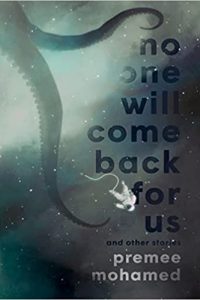Paul Di Filippo reviews C.S.E. Cooney
Bone Swans, by C.S.E. Cooney (Mythic Delirium 978-0988912441, $15.95, 224pp, trade paperback) July 2015
 First came issue one of Mythic Delirium magazine in 1998. Conceived and helmed by accomplished poet, fiction writer, and editor Mike Allen, the magazine is one of those rare long-term survivors of the small-press landscape, with a new issue denominated July-Sept 2015 recently out. Twentieth anniversary just around the bend!
First came issue one of Mythic Delirium magazine in 1998. Conceived and helmed by accomplished poet, fiction writer, and editor Mike Allen, the magazine is one of those rare long-term survivors of the small-press landscape, with a new issue denominated July-Sept 2015 recently out. Twentieth anniversary just around the bend!
But not content with all the duties and travails of publishing a magazine, Allen went on to found Mythic Delirium Books in—so ISFDB opines—the year 2006. Thus he contributes mightily to the health of our genre, publishing good books which the Big Five seem content to overlook.
The latest offering from Mythic Delirium Books is the first collection (five sizable stories) by C. S. E. Cooney, a writer whose work I had not previously sampled, though she began selling with a story, “Lorelei’s Little Deaths,” in 2007.
But I can certainly amend my ignorance now, and so can you, in a vastly entertaining fashion! This is a strong and enduring debut collection.
As might be predicated based on its name, the genre dubbed the “New Weird” has its roots in the Old Weird, and one tendril of those roots extends back to the Weird Tales crew. Thus it’s not too surprising that Cooney’s state-of-the-art New Weird tale “Life on the Sun” at times reads like something from the Robert E. Howard canon, with strange tribes, bizarre magics, desert-circled cities, and other nifty pulp tropes. But of course, since Cooney’s poetic, evocative prose is of a higher order of sophistication than Howard’s, the resulting tale is a thing apart. The city of Rok Moris is undergoing a simultaneous assault from without and rebellion from within. At the heart of both movements, it eventuates, is a young woman named Kantu. Her denied birthright contends with her chosen mature allegiances, and she must somehow reconcile them for the survival of her city and all its citizens.
Cooney invests Kantu with admirable depth of thoughts and emotions, and conjures up a strong supporting cast to set off her virtues. Likewise, her depiction of the cultures of her subcreation and the city of Rok Moris is rich and exciting, given the small compass of the story. The compressed timeframe of the tale—most if it takes place in a day—adds to the propulsive readability. Overall, if the byline had been stripped from this tale, one would not be surprised to hear it came from the pen of Tanith Lee.
Original to this volume, “The Bone Swans of Amandale” reads as if Patricia McKillip and Laird Barron decided jointly to rework the Redwall series. In a land where, among other wonders, a Fairy Mound rises “smooth as a bullfrog,” Maurice the Rat Man must come to the aid of the last Swan Princess, Dora Rose, whom he hopelessly loves and who has seen all her kindred slain, their precious bones turned into musical instruments by the evil ogre Mayor of Amandale, Ulia Gol, whose “florid face was as putridly pink as her wig.” With the help of Nicolas the Pied Piper, suitable reparations are exacted. To say this lively tale recaps its famous model legend is also to say that the Coen Bros.’s O Brother, Where Art Thou? is a straight-ahead rendition of the Labors of Hercules.
“Martyr’s Gem” is both a touching love story and a dire revenge drama. The humble fisherman named Shursta Sarth is inexplicably summoned by one of his land’s elite “blodestone” ladies, Hyrryai, to be her husband. It is a command he cannot refuse. But upon meeting his willy-nilly bride, he discovers that her schemes for him are strictly utilitarian, and do not involve love at all. How he comes to win her heart through many trials is the burden of the account. A Peter Beagle-ish atmosphere pleasantly pervades.
Again a fairy tale or folk legend, that of Rumplestiltskin this time, lays down the template for “How the Milkmaid Struck a Bargain with the Crooked One.” But the joy of the reading is how exotically Cooney embroiders on the basic pattern, offering up unexpected twists and turns and character revisionings. There’s a deep backstory and a large amount of world-building behind the basic plot, and Cooney’s inventiveness extends to her nomenclature too. “Feisty Wold” strikes my ears as a place name worthy of Jack Vance.
Lastly we come to “The Big Bah-Ha.” Tipped off by the back-cover copy that this tale is populated with clowns, you might come to it expecting something like Barry Longyear’s Circus World series. But instead we get the legend of Persephone as if retold by a team-up of Fritz Leiber, Robert Bloch and R.A. Lafferty. The wacked-out prose and characters are just that juicy and off-kilter, both droll and macabre at once. Simply having a personage named “Flabberghast” would be a coup, but there is so much more besides.
In his beguiling and affectionate introduction, Gene Wolfe nominates Cooney as a fully formed savant of fantastika at age eighteen. Having matured and honed her skills since then, as seen in this collection, she surely is embarked on a literary odyssey as rewarding and thrilling as any undergone by her bevy of unforgettable heroes and heroines.




